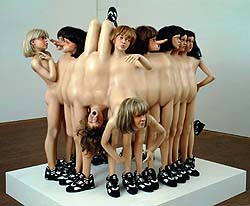|
|
|
So much depends on your point of view... Have you considered, for example, that if Amoebas had a Bible, their book of Genesis would almost certainly tell them to go forth and divide?
Well it's in that spirit---the spirit of going forth and dividing of course--- that I'm going to approach the absolutely devastating news, or, maybe, perhaps, the bloody good news that a warehouse in east London has recently burnt to the ground.
Not, let me be quick to reassure you, that I have anything at all against warehouses conceptually (or actually for that matter): no, no I think that in general they perform a useful if not always architecturally attractive function in out cities. No this bout of forthright if divisive pseudo-quotation has more to do with the contents of this particular warehouse than its mere warehouseyness in general. You see this warehouse warehoused a ---load of ___ (Oh I nearly said a bad word there) of Britart! You know the so called 'conceptual art' that seems to have dominated modern art in Britain for the last too-long-a-time-and-then-some.
Works by the likes of Tracey Emin and Damien Hirst, Sarah Lucas and Gary Hume seem to have been lost. Future art lovers will not be able to see for example Ms Emin's tent - yes I did say 'tent' (as distinct from, say, 'canvas') entitled "Everyone I have ever slept with 1963-95". Gone too is "Hell", by Jake and Dinos Chapman a work consisting of nine miniature landscapes displayed in glass tanks with lots of (like 5,000 or more) little toy soldiers in unpleasant situations doing unspeakable things, all nine (as they call them) 'vitrines' of course (as a rather obvious finishing touch) being set out in the form of a Swastika: this piece, by the way, has been described somewhere as a "hobbyists' Apocalypse". Some of their other work, which looks rather like a collection of Nike Ads for child pornographers was apparently there too:

I wonder how much of that is lost to a grieving posterity. Or perhaps, we should say how much of this a lucky posterity has been saved from.
You see, you see, my problem is that on the one hand (and here I'm speaking as someone who still rankles and fumes at the dissolution of the monasteries and all the concomitant destruction of manuscripts and artifacts done by that swine Northumberland---whom, I would be prepared to bet, prefigured Goebbels, and said at the time "when I hear the word culture I reach for my broadsword") on the one hand, I say, I hate any destruction of any creative works. But on the other hand a lot of this handiwork amounts to little more than being the vicious child of generations of artists who, in order to further their careers and to gain some gallery cred, have had to shock. And while the first time a, say, Duchamp takes a urinal, sticks it on a wall, entitles it “Fountain” and signs the work R. Mutt, or a Picasso leaves out all the parts of a bicycle, apart from the racing handlebars and seat, to make a bull, those acts say something that probably needed saying; but how often does that sort of thing need repeating and does it have any meaning once it becomes the establishment? And is it then worth saving as representing 'the shock of the conventional'?
One could almost see in this fire the hand of God Arbiter doing a little judicious pruning. In fact one of the artists, Jake Chapman, may suspect the same perp here because, just after the fire, he told the London Evening Standard: "I hold God personally responsible and, on a scale of one to 10 of how annoyed I am, I'd say about 11." Finally, it seems interesting to the point of suspicion that this stuff was in a warehouse rather than in someone's home or whatever adding joy or whatever to that someone's life---was it in other words art for appreciating artistically or (and here enters, stage right, the suspicion) art for appreciating financially? Of course if it's the latter then it really is unadulterated good news, at least for those strange souls who collect this sort of stuff and also had the foresight to have it stored in some other warehouse: since art of any sort tends not to be replaceable (even if the artist does it again himself it doesn't have that genuine original feel) the stuff that now survives will belong to a more rarified category and so the collectors' money will be going forth and multiplying.
Cheerio for now
from Richard Howland-Bolton.
|
Notes:
Oh yes! The title is a reference to Charles Saatchi who now owns a lot of melted BritArt
|
 |
 |
<-- Go Back |
|
|

| Home | Essays | Notes | Gallery | Miscellany | Contact |
All contents including writing, cartooning, music, and photography unless otherwise specified are
copyright © 1965-2023 howlandbolton.com and Richard Howland-Bolton. All Rights Reserved.
All logos and trademarks on this site are property of their respective owners. | Web work* by 
*as distinct from Wetwork
  |
|
|

